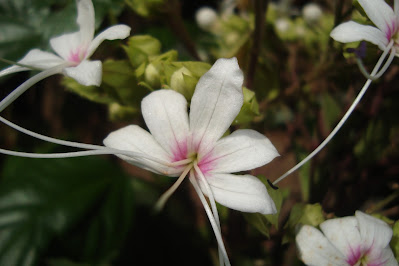
Names of
Hill Glory Bower in different languages
Hill Glory Bower is called Titabhant, Bhant, Motia,
Ghato, Thunera in Hindi

-Ghentu in Bengali
- Kuthap Manbi in Marathi
- Bhanua in Gujrati
- Kalibasuti in Punjabi
- Karukanni, Perugilai,Vellaikkanni in Tamil
- Oruveran, Peruku, Peringalam, Vattapperu, Theetaparuthi ila in Malayalam
- Bokkudu, Chirmabusi, Mandukabrahmi, Mangalagiddi, Pidugudu, Sarasvatiyaku, Guruja, Gurrapu Katilyaku in Telugu
- Ibbane , Garike, Ittevu, Parale, Basavana Pada in Kannada
- In Sanskrit it is called Bhandirah, Barhicuda, Vikacha, Bhantaka, Harita, Mayurachuda, Shirnaromaka, Sthauneyaka, Granthiparna etc.
We call it Genguti in my mother tongue Oriya.
The Botanical name is Clerodendrum infortunatum Linn. (Verbenaceae
family)
The Plant structure of Clerodendrum infortunatum
This highly medicinal perennial flowering shrub is a native of South Asia and it is found throughout India in wild and in road side commonly as a weed. The plant is erect and it often grows to 5 – 7 ft high. The hollow and quadrangular stem is greyish in colour. The hairy leaves slightly ovate, 2- 8 inches wide 3 – 9 inches inside long and are oppositely arranged, the flowers are often white or purplish pink in colour blooming in branch tip in a cluster. The fruit berries turn purplish black, and size up to half inch diameter when ripe. The flowering occurs almost throughout the year.
Medicinal Properties of Clerodendrum infortunatum
The plant has febrifuge, anthelmintic, cholagogue, galactogogue, antimicrobial, diuretic, anti-toxic, vermifuge, antiseptic, laxative, abortifacient, anti-hyperglycemic, antidiabetic, anti-oxidant, anticonvulsant, anti-pyretic, anti-inflammatory, antispasmodic and anti-venom properties.
Ayurvedic and Folk Medicinal use of Hill Glory Bower( Bhant)
The parts of this plant are used as ethno-medicine for treatment of various disorders like Fever, Periodic Fever Headache, Respiratory Diseases, Cough, Asthma, Bronchial Asthma, constipation, diarrhoea, Skin Diseases, Fungal Infections, Alopecia, liver disorders, intestinal worms, venereal and scrofulous problems, blennorrhoea (vaginal mucus discharge disorder). varieties of wounds, Rheumatism, post-natal complications, removing ascarids (worms) in anus. The leaf juice is anti-septic and is often used as a skin wash and a bath for the new born infants suffering with furuncles. A poultice of the leaves is used to reduce any kind of muscle swelling or swelling in stomach, to treat burns, boils, wounds, skin diseases or skin ulcers. The fresh juice of the leaves is applied over fresh wounds for quick healing. The leaf paste when applied on anus cures piles, prolapsed anus, etc. People use the stem as a tooth brush to relieve toothache. The young shoots and leaf extract are given to treat infected vaginal discharge (blennorrhoea). Around 10 ml fresh juice of the leaf can be given to treat liver disorders and remove intestinal worms, to treat fever. Being a laxative, the fresh juice of the leaves is also used to treat constipation. The leaves and flower paste is also used in treatment scorpion sting and young sprouts in snakebite. The root extract is used to treat dysentery, intestinal infection, jaundice, kidney malfunction. The dried root powder mixed with jaggery is given to lactating mothers for increase in breast milk. The root decoction is drunk for cure of both malarial and common fever. Leaves and roots decoction is applied for treatment of tumours, cholera. The ground root is used as a veterinary medicine and is given to domestic animals for treatment of maggot wounds.
No adverse effect of the plant Clerodendrum infortunatum is ever known or reported.
Two famous Ayurvedic medicines called Rasnadi Ghritam (for the treatment of rheumatoid arthritis) and Agastya Rasayanam(for the treatment of respiratory diseases like asthma, bronchitis, cough) are prepared from this plant extracts.

N.B. All the above is solely for informational purpose and NOT INTENDED TO PROVIDE ANY KIND OF MEDICAL ADVICE. A REGD. AYURVEDIC/MEDICAL PRACTITIONER SHOULD ALWAYS BE CONSULTED FOR IT.

